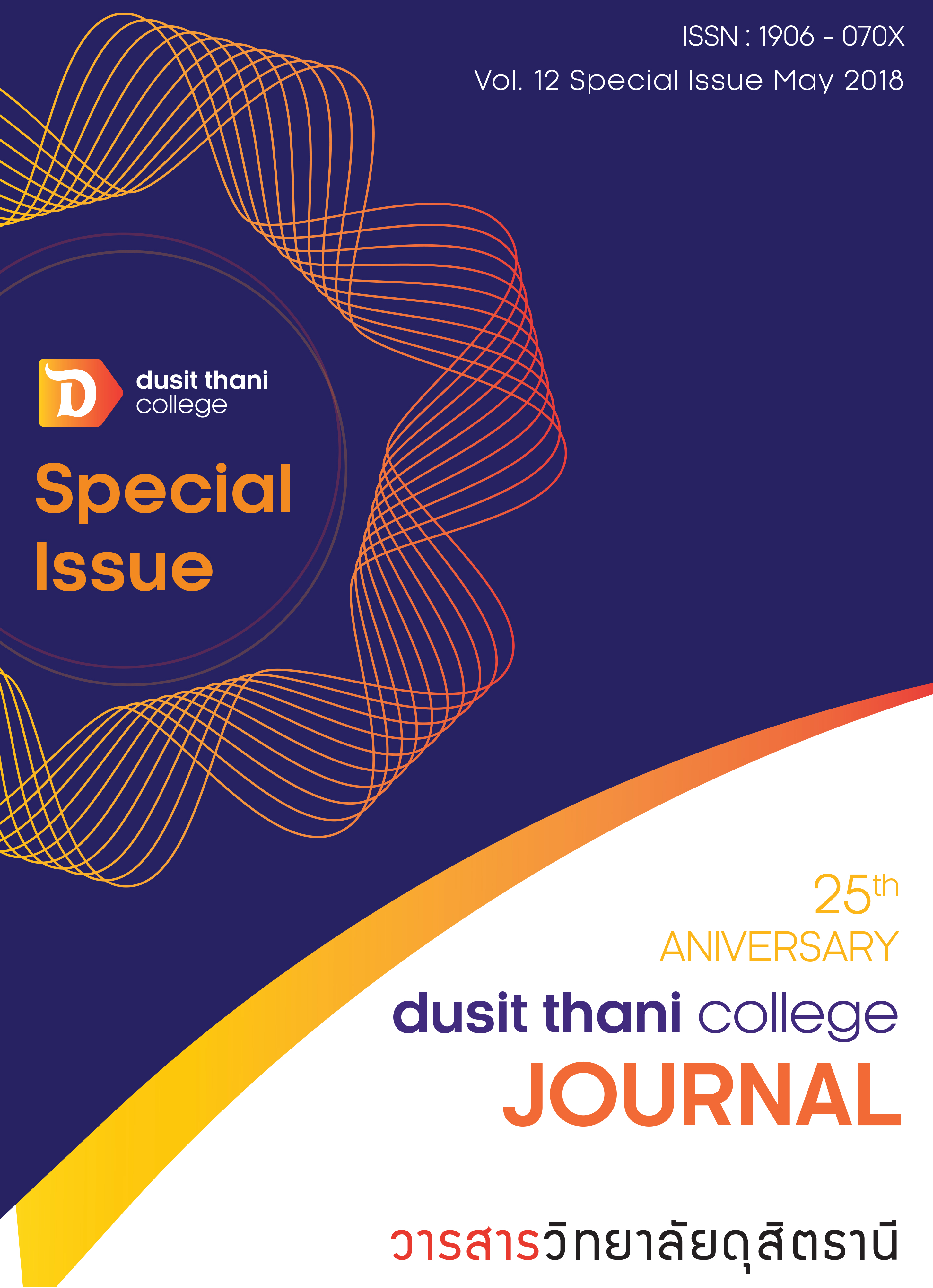การท่องเที่ยวเชิงวัฒนธรรมของจังหวัดจันทบุรี : รูปแบบการพัฒนาศักยภาพ โดยการมีส่วนร่วมของชุมชน
Main Article Content
บทคัดย่อ
การวิจัยนี้มีความมุ่งหมายเพื่อศึกษาสภาพและประเภทของแหล่งท่องเที่ยวเชิงวัฒนธรรม ศึกษาข้อจำกัด ปัญหาของการท่องเที่ยวทางวัฒนธรรม และเพื่อศึกษารูปแบบการพัฒนาศักยภาพของแหล่งท่องเที่ยวเชิงวัฒนธรรมโดยการมีส่วนร่วมของขุมชนในจังหวัดจันทบุรี โดยใช้วิธีการวิจัยเชิงคุณภาพ กลุ่มตัวอย่างที่ศึกษาคือ กลุ่มผู้ให้ข้อมูลหลัก กลุ่มผู้ปฏิบัติ และกลุ่มผู้เกี่ยวข้องรวมทั้งสิ้นจำนวน 103 คน ผู้วิจัยใช้วิธีการคัดเลือกแบบเจาะจง (Purposive Sampling) เครื่องมือที่ใช้ในการวิจัย ได้แก่ แบบสัมภาษณ์เชิงลึก แบบสังเกตแบบมีส่วนร่วม และไม่มีส่วนร่วม และการสนทนากลุ่ม วิเคราะห์ข้อมูลตามจุดมุ่งหมายของการวิจัย ตรวจสอบผลการวิเคราะห์ข้อมูลด้วยวิธีการแบบสามเส้า และนำเสนอผลการศึกษาโดยวิธีวิเคราะห์เชิงพรรณา ผลการวิจัยพบว่า สภาพการณ์ของการท่องเที่ยวเชิงวัฒนธรรมจังหวัดจันทบุรี แบ่งออกได้เป็น 3 ด้าน ได้แก่ 1) ด้านสถาปัตยกรรมโบราณสถาน และประเพณี 2) ด้านอาหาร สินค้าที่ระลึก และที่พักอาศัย และ 3) ด้านภูมิศาสตร์การเกษตร และหัตถกรรม โดยศึกษาวิจัยวิจัยในเขต 1) อำเภอเมือง ที่มีแหล่งอาหาร ศิลปหัตถกรรม และโบราณสถาน 2) อำเภอท่าใหม่ มีศักยภาพด้านภูมิศาสตร์และอาหาร 3) อำเภอแหลมสิงห์ มีศักยภาพด้านโบราณสถานและสินค้าที่ระลึก 4) อำเภอเขาคิชฌกูฏ มีศักยภาพด้านประเพณี แหล่งท่องเที่ยวทางธรรมชาติและที่พัก 5) อำเภอนายายอาม ด้านแหล่งท่องเที่ยวทางธรรมชาติและพิพิธภัณฑ์ ข้อจำกัด ปัญหาของการท่องเที่ยวทางวัฒนธรรมในอำเภอเมืองจันทบุรีพบว่า มีปัญหาด้านการประชาสัมพันธ์ การให้ความรู้แก่นักท่องเที่ยว หลายจุดที่เป็นแหล่งท่องเที่ยวของจังหวัดไม่มีการสร้างเครือข่ายหรือเชื่อมโยงข้อมูลให้ถึงกัน และปัญหาด้านการจรจร อำเภอท่าใหม่พบว่า ความไม่สะอาดของสถานที่ท่องเที่ยว การขาดการประชาสัมพันธ์ ป้ายบอกทางไม่เพียงพอ และปัญหาที่จอดรถของนักท่องเที่ยว อำเภอแหลมสิงห์ พบว่า ขาดการประชาสัมพันธ์เรื่องของการท่องเที่ยวเชิงประวัติศาสตร์ บางสถานที่มีเส้นทางที่ค่อนข้างลำบากต่อการเดินทางโดยสารรถยนต์ อำเภอเขาคิชฌกูฏ พบว่าสถานที่พักมีไม่เพียงพอต่อนักท่องเที่ยว ปัญหาช้างป่าที่อาละวาดต่อนักท่องเที่ยว และปัญหาขยะที่มีจำนวนมาก อำเภอนายายพบว่า ปัญหาเรื่องการบริหารจัดการเรื่องสิ่งปฏิกูล และปัญหาการปิด เปิดสถานที่ท่องเที่ยวไม่มีกำหนดเวลาที่ชัดเจน และรูปแบบการพัฒนาศักยภาพโดยการมีส่วนร่วมของชุมชน เพื่อการเพิ่มศักยภาพการท่องเที่ยวเชิงวัฒนธรรมของจังหวัดจันทบุรี พบว่า ต้องดำเนินการกำหนดนโยบายและวางแผนรูปแบบการพัฒนาศักยภาพโดยการมีส่วนร่วมของชุมชนให้มีคุณภาพ และสามารถสร้างมูลค่าเพิ่มก่อให้เกิดรายได้ให้กับคนในชุมชนจังหวัดจันทบุรี โดยสรุปการท่องเที่ยวเชิงวัฒนธรรม รูปแบบการพัฒนาศักยภาพโดยการมีส่วนร่วมของชุมชน ภายใต้บริบทของสังคม และวัฒนธรรมที่เน้นการมีส่วนร่วมของชุมชน เพราะปัจจุบันการท่องเที่ยวมีอิทธิพลต่อสังคม และวัฒนธรรมเป็นอย่างมาก ในแต่ละปีการท่องเที่ยวสามารถสร้างรายได้ให้กับประเทศไทยนับเป็นมูลค่ามหาศาล แต่ด้วยการพัฒนาด้านการท่องเที่ยวที่มุ่งหวังผลประโยชน์อย่างเดียว อาจเกิดผลกระทบต่อระบบของสังคมและวัฒนธรรม ดังนั้นการวางแผนที่จะพัฒนาด้านการท่องเที่ยวจึงต้องคำนึงถึงรูปแบบที่เหมาะสม เพื่อเป็นการส่งเสริมการท่องเที่ยวให้มีประสิทธิภาพและยั่งยืนสืบไป
Article Details
นโยบายการพิจารณากลั่นกรองบทความ
- บทความวิจัยและบทความวิชาการทุกเรื่องที่จะได้รับการตีพิมพ์ต้องผ่านการพิจารณากลั่นกรองโดยผู้ทรงคุณวุฒิ (Peer Review) ในสาขาที่เกี่ยวข้อง จำนวน 3 ท่าน/บทความ
- บทความ ข้อความ ภาพประกอบและตารางประกอบที่ลงตีพิมพ์ในวารสารเป็นความคิดเห็นส่วนตัวของผู้เขียน กองบรรณาธิการไม่จำเป็นต้องเห็นด้วยเสมอไป และไม่มีส่วนรับผิดชอบใด ๆ ถือเป็นความรับผิดชอบของผู้เขียนแต่เพียงผู้เดียว
- บทความที่จะได้รับการตีพิมพ์จะต้องไม่เคยตีพิมพ์ เผยแพร่ที่ใดมาก่อน และไม่อยู่ระหว่างการพิจารณาของวารสารฉบับอื่น หากตรวจสอบพบว่ามีการตีพิมพ์ซ้ำซ้อน ถือเป็นความรับผิดชอบของผู้เขียนแต่เพียงผู้เดียว
- บทความใดที่ผู้อ่านเห็นว่าได้มีการลอกเลียนหรือแอบอ้างโดยปราศจากการอ้างอิง หรือทำให้เข้าใจผิดว่าเป็นผลงานของผู้เขียน กรุณาแจ้งให้กองบรรณาธิการวารสารทราบจะเป็นพระคุณยิ่ง
เอกสารอ้างอิง
A Model for Cultural Tourism Development and Management. Journal of Liberal Arts, Ubon Ratchathani University. 7(1): 81-125.
Kontogeorgopoulos, N., Churyen, A., and Duangsaeng, V. (2014). Success factors in community-based tourism in Thailand: The role of luck, external support, and local leadership. Tourism Planning & Development. 11(1): 106-124.
Kontogeorgopoulos, N., Churyen, A., and Duangsaeng, V. (2015). Homestay tourism and the commercialization of the rural home in Thailand. Asia Pacific Journal of Tourism Research. 20(1): 29-50.
Mason, P. (2015). Tourism impacts, planning and management. London: Routledge.
Mazmanian D. and Sabatier P. (1983). Implementation and public policy. Palo Alto, CA: Scott.
Na Ranong, S. (2002). Community based tourism management: A case study of the communities surrounding Namtok Phlio National Park. Bangkok: Thammasat University Press. Page, S. J. (2014). Tourism management. London: Routledge.
Pearce, P. L., & Thanksooks, J. (2016). Towards the future of the domestic hotel in Thailand: A timeline approach. Journal of Vacation Marketing, 22(3), 199-211.
Peleggi, M. (1996). National heritage and global tourism in Thailand. Annals of tourism research, 23(2): 432-448.
Sakdiyakorn, M. and Sivarak, O. (2016). Innovation management in cultural heritage tourism: experience from the Amphawa waterfront community, Thailand. Asia Pacific Journal of Tourism Research. 21(2): 212-238.
Sankrusme, S. (2017). Potential Development Strategies on Marine and Beach Tourism. Bangkok: Anchor Academic Publishing.
Sin, H. L., & Minca, C. (2014). Touring responsibility: The trouble with ‘going local’ in community-based tourism in Thailand. Geoforum. 51(1): 96-106.
Sittijinda, P., Poungsuk, P. and Rodchamnan, T. (2016). Potential Development on Agro-tourism Participated by Khlung Community, Chanthaburi, Thailand. Journal of Agricultural Technology. 12(7.2): 1735-1743.
Srisangkaew, K. (2017). Advanced destination marketing strategy for Chanthaburi Province, Thailand. International Journal of Business and Economic Affairs (IJBEA), 2(1): 77-84.
Su, M. M., & Wall, G. (2014). Community participation in tourism at a world heritage site: Mutianyu Great Wall, Beijing, China. International Journal of Tourism Research. 16(2): 146-156.
Sujaritchai, S. and Artnarong, W. (2017). Assessment of tourism attraction potentials in 3 eastern borders provinces. Journal of Thai Interdisciplinary Research. 11(6): 14-19.
Szuster, B. W. and Dietrich, J. (2014). Small Island Tourism Development Plan Implementation: The Case of Koh Tao, Thailand. Environment Asia. 7(2): 124-132.
Wisootthipaet, S. (2015). Local Food Wisdom: The Management for Tourism in the Eastern Region of Thailand. Silpakorn University Journal of Social Sciences, Humanities, and Arts. 15(3): 177-196.
Wongtada, N., & Krairit, D. (2017). Survival of a market leader in a regional integration of emerging economies: A case study of the tourism industry in Thailand. Journal of the International Academy for Case Studies, 23(1).
Wongwanit, W. (1996). The geography of tourism. Bangkok: Thammasat University Press.
World Tourism and Travel Council (WTTC). (2011). World tourism and travel council data homepage [Online]. Available at: https://www.wttcorg/research/economicdata-search-tool/
Yutaraksanugul, Y. (2003). Agro-tourism site planning and management at Chanthaburi Horticultural Research Centre, Chanthaburi Province. Bangkok: Kasetsart University Press.


